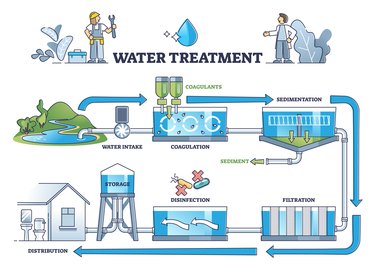Tailored water treatment polymer formulations address specific industry needs.
Tailored water treatment polymer formulations address specific industry needs.
Blog Article
Find Out About the Relevance of Water Treatment Polymer for Lasting Water Resources
Water therapy polymers are essential components in the administration of sustainable water sources, playing a crucial role in the purification and enhancement of water high quality. As we challenge raising eco-friendly challenges, the evolution of these polymers increases important questions regarding their future function in water treatment methods.
What Are Water Therapy Polymers?
Water treatment polymers are specialized chemical substances made to improve the effectiveness of water purification processes. These polymers play a critical duty in different applications, including municipal wastewater therapy, industrial effluent management, and alcohol consumption water filtration.
The use of water therapy polymers can significantly boost the removal of contaminants such as natural matter, heavy steels, and pathogens. By maximizing the coagulation and flocculation procedures, these polymers enable greater clearing up prices and clearer effluent, which is vital for meeting regulative compliance and ecological standards.
In addition, water treatment polymers can be created to attend to specific difficulties within various water treatment systems, such as differing pH levels, temperature levels, and pollutant kinds (water treatment polymer). Their adaptability and effectiveness make them vital in achieving lasting water management methods. As water scarcity becomes a boosting global worry, the role of water treatment polymers comes to be ever a lot more essential in guaranteeing the accessibility of tidy and secure water sources

Advantages of Water Treatment Polymers

The benefits of making use of water therapy polymers are manifold, significantly enhancing functional efficiency and effectiveness in purification processes. These polymers play a vital function in coagulation and flocculation, enabling the efficient elimination of put on hold solids and pollutants from water. By promoting the aggregation of bits, they assist in the development of bigger flocs that can be quickly separated from the liquid phase, thus improving the overall clarity and top quality of the cured water.
In addition, water therapy polymers add to minimized chemical usage, resulting in cost savings and decreased ecological influence. Their capability to carry out efficiently at lower does suggests that operational expenses can be dramatically minimized while still attaining premium water therapy results.
Moreover, these polymers exhibit superb security and compatibility with numerous water problems, making them suitable for a varied variety of applications. They likewise enhance sludge dewatering procedures, resulting in decreased waste quantity and lower disposal costs. Ultimately, using water therapy polymers supports conformity with regulative standards, ensuring that cured water meets crucial security and quality needs. Overall, these benefits setting water therapy polymers as vital components in the quest of lasting water resource monitoring.
Applications in Water Therapy
Numerous applications of water treatment polymers highlight their convenience and effectiveness in various filtration procedures. These polymers are integral in flocculation and coagulation, where they help with the aggregation of put on hold bits, leading to boosted sedimentation and filtering. In local water therapy centers, they boost the removal of raw material, turbidity, and microorganisms, adding to the manufacturing of secure drinking water.

Furthermore, in the context of safe and clean water therapy, polymers help in controlling taste and smell, making certain consumer complete satisfaction. Their role includes taking care of sludge dewatering, enhancing waste management procedures and minimizing disposal expenses. Overall, the varied applications of water treatment polymers make them essential for maintaining water top quality and sustainability across numerous markets, ultimately sustaining public health and wellness and environmental stewardship.
Ecological Impact of Polymers
Substantial worries regarding the ecological impact of water therapy polymers have become their extensive usage remains to expand. These synthetic substances, mainly made use of as coagulants and flocculants in water treatment procedures, can position threats to aquatic ecosystems and human health otherwise handled properly.

Moreover, the production and disposal of water treatment polymers contribute to carbon discharges and air pollution. The production procedures next page often include hazardous chemicals, which can have damaging results on the setting otherwise adequately controlled.
To reduce these effects, it is vital to explore biodegradable choices and boost reusing methods for existing polymers - water treatment polymer. Implementing more stringent guidelines and promoting research on lasting polymer advancement can also play an essential role in decreasing ecological damage while maintaining reliable water treatment solutions
Future of Water Therapy Technologies
Developments in water therapy innovations are increasingly improving exactly how we come close to the filtration and management of water resources. Arising innovations, including nanotechnology, membrane layer filtering, and progressed oxidation processes, are enhancing the effectiveness and effectiveness of water therapy systems. These technologies not just improve the elimination of contaminants however also lower energy intake and operational expenses.
The integration of artificial knowledge and machine discovering is revolutionizing tracking and control systems, enabling real-time data evaluation and anticipating maintenance. This brings about more receptive and flexible treatment processes, making sure that water quality meets regulative criteria while optimizing resource usage.
In addition, the development of eco-friendly water treatment polymers is critical for achieving sustainability goals. These polymers can improve coagulation and flocculation procedures, reducing the reliance on conventional chemicals and lessening ecological influence.
As water scarcity becomes a progressively pushing worldwide concern, the future of water therapy innovations will likely concentrate on decentralization, enabling localized treatment services that are both durable and versatile to altering problems. The partnership in between research study establishments, sector stakeholders, and federal government entities will certainly be crucial for driving innovation and ensuring the sustainable management of water resources for future generations.
Conclusion
In final thought, water therapy polymers are essential for improving the purification go to this site refines required for lasting water resource management. As the demand for effective and sustainable water therapy options enhances, the ongoing development in polymer modern technology will be crucial to resolving future water high quality obstacles.
Report this page